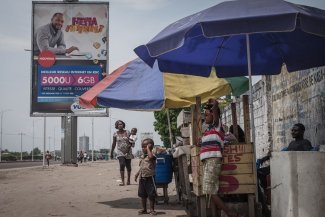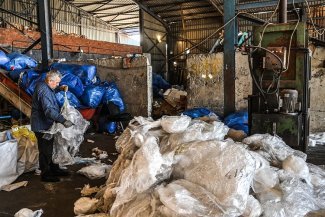Regina Paluckienė and her husband Gytis made a promising start as organic farmers. After trading life in the Lithuanian capital of Vilnius for the north-eastern district of Kupiškis, they blogged enthusiastically about their thatched house and exotic free-range pigs. But less than two years later, a deadly virus put an end to their dream.
In January 2014, Lithuania reported its first case of African swine fever (ASF), a highly contagious and usually deadly hemorrhagic disease affecting pigs, warthogs and wild boar. Soon after Poland, Estonia and Latvia followed.
Outbreaks were recorded in self-subsistence and small-scale farming, as well as large commercial pig farms, prompting the European Commission to restrict the transportation and trade of pork in affected zones.
ASF is mainly transmitted through meat, faeces and fodder. There are no vaccines or treatment for the disease, and while it does not affect humans and did not trigger the mass mobilisation seen against other forms of swine or avian flu, the European Union feared a threat to its exports.
As a result, between 2014 and 2015 over 22,000 pigs were culled in Estonia, 777 were culled in Latvia and over 19,000 pigs were culled in Lithuania. Unfortunately, this year there have still been new outbreaks of ASF.
Lithuania, which has been dealing with the virus for the longest period of time in the region, has reduced its wild boar population by nearly two-thirds according to the Environment Ministry, and yet farms are still falling victim to ASF.
As well as the culling, traditional swill feeding on small farms has been banned and farms in affected areas have had to introduce strict biosecurity measures to isolate pigs from all other areas.
Another controversial measure to try to control the spread of the virus has been the decree that when one farm fails to comply with the new measures, other farms nearby must also destroy its uninfected pigs. Experts say that such a measure is unavoidable, but it has left scores of farmers devastated and jobless in rural areas with already high levels of unemployment.
The crisis has also pitted large-scale farmers against small-scale farmers, with each side is blaming the other for the emergency.
“Destroying Lithuanian pigs is the easiest way for large farmers to get rid of competitors,” Vidas Juodsnukis, who chairs the Lithuanian Family Farmers Union, told Equal Times. He cited the example of two municipalities where farmers that paid to install biosecurity measures were nonetheless ordered to destroy their pigs because their region was declared contaminated.
Raising free-range pigs, which do not need special facilities, became out of the question for Regina and Gytis, so they closed their business. Today, Regina stays at home to look after their children, while Gytis works in town.
Like other small farmers, they were supposed to receive advice from their municipal veterinary authorities, but Regina feels that officials are “more used to disciplining and prohibiting, rather than informing.”
On the other hand, Lithuania’s State Food and Veterinary Service has criticised some villagers for “irresponsible” farming, citing an example of a man who buried an infected pig in his backyard instead of reporting it to the authorities.
The Lithuanian Pig Producers Association estimates that commercial farmers in the most restricted zones lost €447,000 (US$500,000) between December 2015 and July 2016. The head of the association, Algis Baravykas, said six companies have closed because they fell under restricted zones, and that 105 pig farm workers in Lithuania have lost their jobs since 2014.
However, Baravykas remains pragmatic. “All this talk about traditions and destruction of village life is poetic. But the situation is extreme and requires extreme measures.”
In a letter to Lithuania’s EU Commissioner Vytenis Andriukaitis, the association complained that affected countries, as well as the EU at large, had failed to control the spread of the virus from Belarus though wild boar migration, trade and undocumented traffic of ‘unsafe’ meat products.
According to the association, EU measures regulating transportation, sales and exports of pork fail to incentivise small farmers – who can keep up to 100 pigs – to ensure the highest levels of biosecurity.
Trade has suffered
The Commission suggests that the virus strain originated in Russia, which buys a quarter of the EU’s pork exports and 18 per cent of Lithunia’s. Russia itself introduced an EU-wide pork import ban in February 2014, which the EU disputed at the World Trade Organization (WTO) and won this August.
The Baltic states lobbied for the European Commission to allow internal trade in pork from affected areas, with some success. But according to Copa-Cogeca, which represents the interests of European farmers and agri-cooperatives at the EU level, these stringent measures “ensure that pigs and pig products can be put safely on the EU market and exported to trade partners,” according to its press officer, Amanda Cheesley.
In August this year, the European Commission extended ASF control measures to certain areas in Poland after new outbreaks were reported. Copa-Cogeca says that strict zoning after each outbreak, which brings losses to commercial farms, should be combined with adequate EU compensation.
Lithuanian farmers could apply for compensation from a fund of €379,000 (US$425,000) for this year. But many farmers have failed to do so because they feel it would be too much hassle while others have missed the application deadline.
Aldona Pigagienė, who owns a pork processing business in Nedzingė village in the Varėna district municipality of south-eastern Lithuania, told Equal Times that she culled her pigs and laid off six slaughterhouse workers when her municipality was amongst the first affected. She tried for a time to make cheese instead.
Now Pigagienė says she regrets having investing in the adaptation of her slaughterhouse to fit EU regulations in 2008, since her company now buys imported meat. She did not ask for subsidies, fearing that the application process would take too long. “We once applied for funds and had to give it back – the equipment we needed became two times more expensive as we waited for the documents.”
But farmers are not the only ones who are frustrated with the updated regulations. Eugenijus Tijušas, the Lithuanian Hunters and Fishers Union’s deputy head for hunting, does not mince his words on some of the proposed measures to combat ASF.
“Most of these officials have only seen a wild boar only on TV. Hunters make fun of those measures but they must comply,” he says, referring to a directive from Brussels which called for the limited feeding of wild boar and the targeted hunting of female boars in an attempt to reduce their numbers.
“Wild boar are strictly territorial animals. When their density is low, they walk longer distances for mating and form larger herds. Countries with the highest wild boar density do not suffer from ASF,” Tijušas tells Equal Times.
Learning to live without pigs
For Janina (who declined to give her surname), a subsistence farmer from Vievis ward between Vilnius and Kaunas in the eastern central region of Lithuania, prematurely slaughtering her pigs this summer has meant more than just making a financial loss.
“It is easier to live when you have your own meat,” says Janina, who is retired. The average pension in Lithuania is just €255 (US$285), and villagers traditionally provide meat for extended family and relatives in the cities.
Janina, like many other villagers, complains that pigs were the only animals that it made financial sense to breed. “Nobody comes to purchase our milk, but pigs grow well when fed milk. We would boil potatoes, scald some flour and mix it with milk. They would gain 200 kilograms in a year.”
Similar to Regina and Gytis, Janina liked the fact that pigs were cheap to maintain and fit well into the local ecosystem. This makes it difficult to replace them with other animals, despite the availability of subsidies for that specific purpose.
The Ministry of Agriculture pledged around €355,000 (US$398,000) to substitute pigs with other animals this year, but so far less than one-tenth of that was disbursed. Pigagienė, who has been in pork business for 20 years, is pessimistic: “If I could go back in time, I would think twice about raising pigs at all.”









